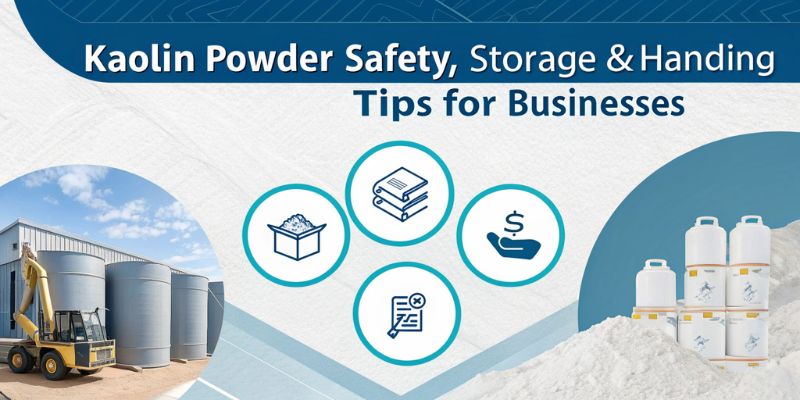
Kaolin Powder Safety, Storage and Handling Tips for Businesses
Kaolin powder, also known as china clay, is a versatile mineral widely used across industries such as ceramics, paper, rubber, paints, and cosmetics. While kaolin powder is generally considered non-toxic, improper handling, storage, or usage can lead to health hazards, contamination, or reduced product quality. For businesses dealing with kaolin powder, following proper safety, storage, and handling protocols is crucial. This guide provides essential tips for businesses to ensure safe and efficient use of kaolin powder.
1. Understanding Kaolin Powder
Kaolin powder is a naturally occurring clay mineral primarily composed of kaolinite. Its fine texture, whiteness, and chemical stability make it valuable for multiple applications, including:
- Ceramics: Enhances the strength and whiteness of porcelain and tiles.
- Paper Industry: Used as a coating and filler to improve brightness and smoothness.
- Cosmetics: Key ingredient in face masks, soaps, and powders.
- Paints & Rubber: Improves texture, opacity, and durability.
Knowing the properties of kaolin powder helps businesses handle it safely and maintain its quality during storage and transportation.
2. Safety Precautions for Handling Kaolin Powder
Even though kaolin is non-toxic, inhalation of fine particles over time can irritate the respiratory system. Here are important safety tips:
Wear Protective Gear:
- Use dust masks or respirators to prevent inhalation.
- Wear gloves and protective clothing to avoid prolonged skin contact.
- Use safety goggles to prevent irritation to the eyes.
Ensure Proper Ventilation:
- Work in well-ventilated areas to reduce airborne dust.
- Use local exhaust ventilation systems in factories or processing units.
Avoid Direct Ingestion:
- Keep kaolin powder away from food or drink.
- Ensure workers wash their hands thoroughly after handling.
First Aid Measures:
- If inhaled: Move to fresh air immediately.
- If skin contact occurs: Wash thoroughly with soap and water.
- If eye contact occurs: Rinse with plenty of water and seek medical attention if irritation persists.
3. Proper Storage of Kaolin Powder
Maintaining the quality of kaolin powder requires careful storage. Moisture, contamination, or extreme temperatures can affect its properties.
- Keep Dry and Cool: Store kaolin powder in a dry environment, away from direct sunlight and moisture.
- Use Sealed Containers: Bags or containers should be tightly sealed to prevent contamination and dust escape.
- Avoid Cross-Contamination: Store separately from chemicals, fertilizers, or materials that may react with kaolin.
- Label Containers Clearly: Always mark the product name, batch number, and handling instructions for easy identification.
4. Handling Tips for Businesses
Proper handling ensures worker safety and prevents wastage. Follow these tips:
- Use Mechanical Equipment: Use scoops, shovels, or conveyors to reduce manual contact.
- Minimize Dust Generation: Transfer kaolin powder slowly and carefully to prevent airborne dust.
- Regular Cleaning: Sweep or vacuum storage and handling areas to maintain hygiene.
- Train Employees: Educate staff on safety protocols, emergency measures, and proper handling techniques.
5. Transportation Tips for Kaolin Powder
Transporting kaolin powder safely is crucial to prevent spillage and contamination:
- Use Covered Containers: Prevent dust dispersion during transit.
- Secure Packaging: Ensure bags or drums are properly sealed and stacked.
- Follow Regulations: Comply with local transport regulations for handling mineral powders.
6. Environmental Considerations
Responsible businesses consider the environmental impact of kaolin powder:
- Prevent Dust Emission: Install dust control systems to minimize air pollution.
- Waste Management: Dispose of kaolin residues responsibly.
- Recycling: Reuse or recycle kaolin waste wherever possible to reduce the environmental footprint.
7. Key Takeaways
For businesses handling kaolin powder, safety, storage, and proper handling are essential to maintain product quality and protect employees. Here’s a quick summary:
- Wear protective gear and ensure proper ventilation.
- Store in dry, sealed, and labeled containers.
- Handle carefully to prevent dust generation and contamination.
- Train staff and follow transport and environmental safety guidelines.
By following these tips, businesses can efficiently use kaolin powder while ensuring safety and compliance with industrial standards.
Conclusion
Handling kaolin powder safely is essential for any business that uses this versatile mineral. By following proper safety measures, storing the powder correctly, and training employees in effective handling techniques, businesses can prevent health hazards, maintain product quality, and ensure regulatory compliance. Responsible transportation, environmental awareness, and regular monitoring further enhance safety and efficiency. Adopting these practices not only protects workers but also strengthens the reputation of businesses as safe and professional operators in industries utilizing kaolin powder.
Frequently Asked Questions (FAQs)
Q1. Is kaolin powder safe?
Yes, but avoid inhaling dust and use protective gear.
Q2. How should it be stored?
Store in dry, sealed containers away from moisture and sunlight.
Q3. What protective gear is needed?
Use masks, gloves, goggles, and protective clothing
Q4. Which industries use kaolin powder?
Ceramics, paper, paints, rubber, and cosmetics.
Q5. How to minimize dust during handling?
Use mechanical tools and maintain clean, ventilated areas.